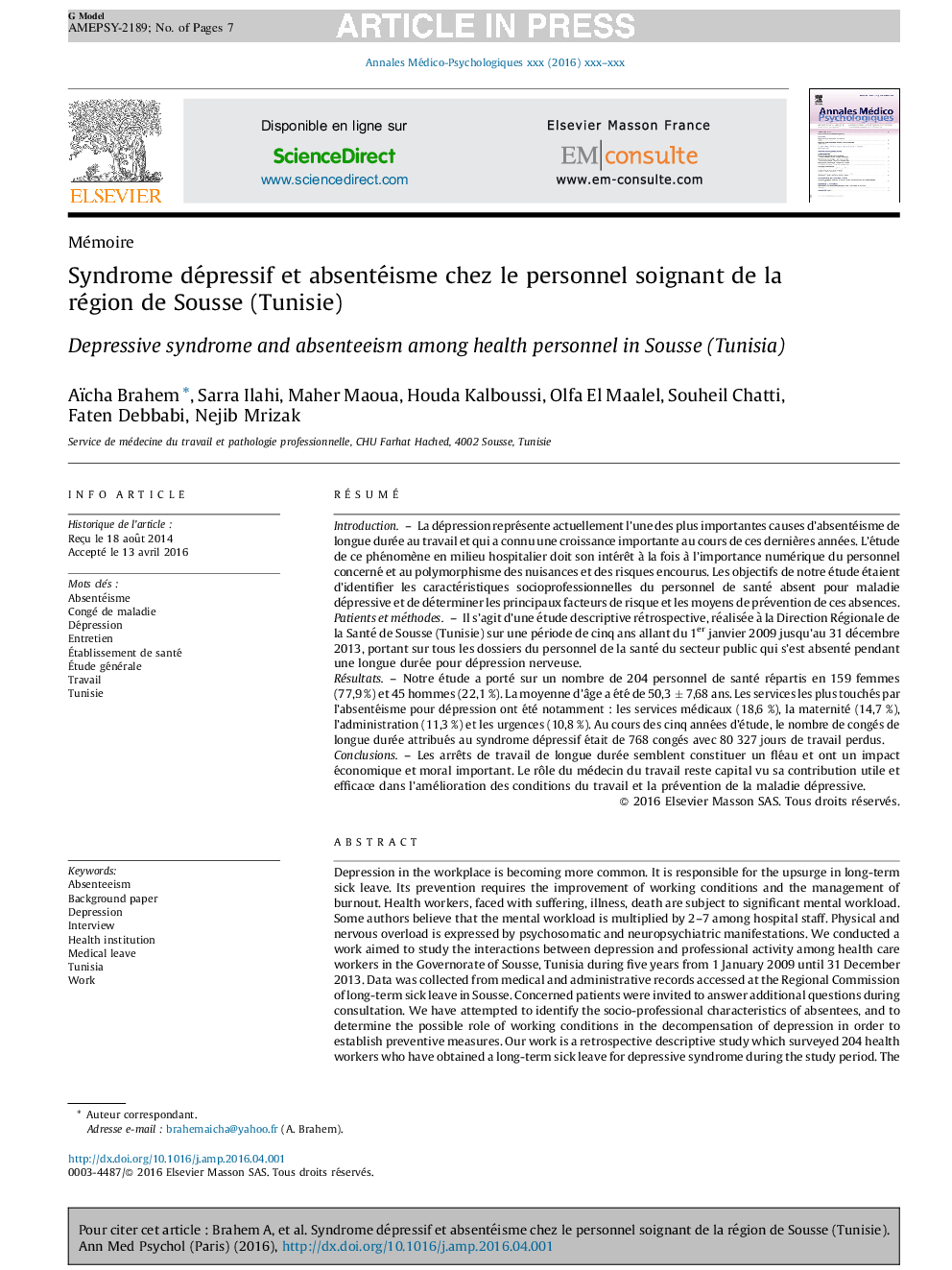| کد مقاله | کد نشریه | سال انتشار | مقاله انگلیسی | نسخه تمام متن |
|---|---|---|---|---|
| 6786487 | 1432386 | 2016 | 7 صفحه PDF | دانلود رایگان |
عنوان انگلیسی مقاله ISI
Syndrome dépressif et absentéisme chez le personnel soignant de la région de Sousse (Tunisie)
دانلود مقاله + سفارش ترجمه
دانلود مقاله ISI انگلیسی
رایگان برای ایرانیان
کلمات کلیدی
موضوعات مرتبط
علوم پزشکی و سلامت
پزشکی و دندانپزشکی
روانپزشکی و بهداشت روانی
پیش نمایش صفحه اول مقاله

چکیده انگلیسی
Depression in the workplace is becoming more common. It is responsible for the upsurge in long-term sick leave. Its prevention requires the improvement of working conditions and the management of burnout. Health workers, faced with suffering, illness, death are subject to significant mental workload. Some authors believe that the mental workload is multiplied by 2-7Â among hospital staff. Physical and nervous overload is expressed by psychosomatic and neuropsychiatric manifestations. We conducted a work aimed to study the interactions between depression and professional activity among health care workers in the Governorate of Sousse, Tunisia during five years from 1Â January 2009Â until 31Â December 2013. Data was collected from medical and administrative records accessed at the Regional Commission of long-term sick leave in Sousse. Concerned patients were invited to answer additional questions during consultation. We have attempted to identify the socio-professional characteristics of absentees, and to determine the possible role of working conditions in the decompensation of depression in order to establish preventive measures. Our work is a retrospective descriptive study which surveyed 204Â health workers who have obtained a long-term sick leave for depressive syndrome during the study period. The prevalence of absenteeism was estimated to 4.45%. Some employees have submitted more than one sick leave, which raises the number of sick leaves to 768Â during the study period. The study population is relatively young, with about 50.9% of absentees aged between 50Â and 59Â years. A female predominance was noted (77.9% of absentees). Our population was composed mainly of married employees (79.9%) which had, in 88.7% of cases, at least one dependent child. Older paramedics were more affected than any other occupational group. The most affected services were, in descending order, medical, gynecological and obstetric services, administrative services, emergency services, outpatient and finally pediatric services. Most common medical affections were hypertension, diabetes, cancer and rheumatic diseases. Personal history of psychiatric diseases was mentioned by 38% of cases. As pointed by many authors, healthcare workers commonly relate the genesis of their psychiatric disorder to socio-professional conditions. Physical load was declared by 46.1% of cases and metal overload was described by 27.9% of questioned workers. Other common stressing situation was the permanent contact with patients and/or their family. Conflictual relationship with colleagues and/or superiors was declared by 17.6% of cases. It appears from our study that 10.8% of absent for depressive syndrome feel insecure in their work. This feeling seems to be more pronounced in recent years after the revolution in Tunisia (2011). Indeed, the rate of violence against care workers has tripled after the revolution. The most important consequence of this disease is long-term absenteeism which has an expensive cost expressed by economic and social outcomes. In our survey, we found that the absenteeism was 21.57% with 80,327Â lost working days which is pretty near to 44Â years lost per year of work during the of study period. The analysis of our results showed that the absenteeism indicators are very high and it is urgent to have a real plan of action. This plan primarily affects prevention. The management of depression in the workplace requires a multidisciplinary intervention and better coordination between occupational physician and psychiatrist or psychologist.
ناشر
Database: Elsevier - ScienceDirect (ساینس دایرکت)
Journal: Annales Médico-psychologiques, revue psychiatrique - Volume 174, Issue 7, September 2016, Pages 557-563
Journal: Annales Médico-psychologiques, revue psychiatrique - Volume 174, Issue 7, September 2016, Pages 557-563
نویسندگان
Aïcha Brahem, Sarra Ilahi, Maher Maoua, Houda Kalboussi, Olfa El Maalel, Souheil Chatti, Faten Debbabi, Nejib Mrizak,